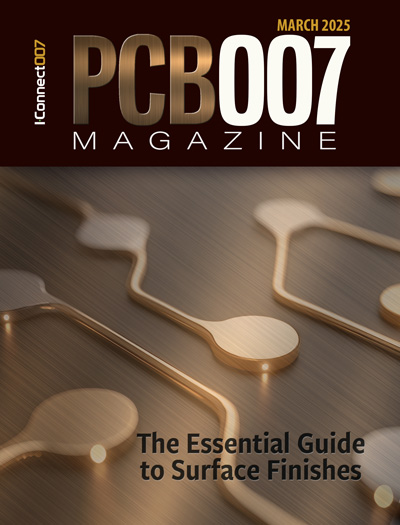-

- News
- Books
Featured Books
- pcb007 Magazine
Latest Issues
Current Issue
In Pursuit of Perfection: Defect Reduction
For bare PCB board fabrication, defect reduction is a critical aspect of a company's bottom line profitability. In this issue, we examine how imaging, etching, and plating processes can provide information and insight into reducing defects and increasing yields.

Voices of the Industry
We take the pulse of the PCB industry by sharing insights from leading fabricators and suppliers in this month's issue. We've gathered their thoughts on the new U.S. administration, spending, the war in Ukraine, and their most pressing needs. It’s an eye-opening and enlightening look behind the curtain.

The Essential Guide to Surface Finishes
We go back to basics this month with a recount of a little history, and look forward to addressing the many challenges that high density, high frequency, adhesion, SI, and corrosion concerns for harsh environments bring to the fore. We compare and contrast surface finishes by type and application, take a hard look at the many iterations of gold plating, and address palladium as a surface finish.
- Articles
- Columns
Search Console
- Links
- Media kit
||| MENU - pcb007 Magazine
Using Big Databases to Find Superconductors of the Future
January 14, 2019 | ACN NewswireEstimated reading time: 2 minutes
Japanese researchers have found an approach to more quickly and successfully identify superconducting materials.
"The data-driven approach shows promising power to accelerate the discovery of new thermoelectric and superconducting materials," the researchers say in their study published in the journal Science and Technology of Advanced Materials.
Superconductors are materials that conduct electricity with virtually no resistance. Superconducting materials have improved the field of magnetic resonance imaging (MRI) and have led to the development of particle colliders that can be used for research related to splitting atoms. Currently available superconducting materials can only perform at extremely low temperatures. If researchers can find superconducting materials that work at ambient temperature, electricity could be conducted over large distances without energy loss.
Current approaches to searching for these materials are somewhat random, and results strongly depend on researcher's intuition, experience and luck. Materials scientist Yoshihiko Takano of Japan's National Institute for Materials Science and colleagues have shown that sifting through an inorganic materials database using specific search parameters can provide a more systematic way to finding superconducting materials.
They searched through AtomWork, a large database for inorganic materials. In a previous study using this same approach, the team identified SnBi2Se4 (a compound of tin, bismuth, and selenium) as a potential superconductor. Experiments showed that this was indeed the case.
But SnBi2Se4 requires very low temperatures and high pressures to become superconductive. The team searched once more through the database, selecting materials that have a similar crystal structure to SnBi2Se4 but a narrower 'band gap', a property related to atomic structure that allows electrons to jump up from one energy level to another and thus partake in electrical conductivity.
Their best choice was PbBi2Te4 (formed of lead, bismuth, and tellurium). They synthesised PbBi2Te4 crystals, examined their structure, chemical composition and other properties, and found that those properties met the predictions. They exposed the crystals to high pressures and varying temperatures and found that the electrical resistance of PbBi2Te4 decreased with increasing pressure, reaching a superconductive state at 10 gigapascals, about half the pressure needed for SnBi2Se4 to become superconductive.
This work "presents a case study for the important first-step for the next-generation data-driven materials science," the team concludes.
About Science and Technology of Advanced Materials (STAM) Journal
Open access journal, STAM publishes outstanding research articles across all aspects of materials science, including functional and structural materials, theoretical analyses, and properties of materials.
Suggested Items
Technica Expands into Emerging Printed Electronics and Advanced Coatings Markets
06/04/2025 | Technica USATechnica is expanding its product portfolio with Agfa’s advanced line of Orgacon conductive coatings. The Orgacon products are a natural complement to Technica’s existing solutions and will allow the company to deliver greater value to customers in these markets.
Panasonic Appoints Matrix as its Authorized Distributor in Europe
06/03/2025 | Matrix ElectronicsEffective July 1st, 2025, Panasonic Industry Co., Ltd. has appointed Matrix Electronics Limited as its Authorized Distributor in the European region.
Indium Joins Virginia Tech Center for Power Electronics Systems Industry Consortium
06/03/2025 | Indium CorporationIndium Corporation®, a leading materials refiner, smelter, manufacturer, and supplier to the global electronics, semiconductor, thin-film, and thermal management markets, has joined Virginia Tech’s Center for Power Electronics Systems (CPES), an industry consortium that supports power electronics initiatives to reduce energy use while growing capability.
Strategic Materials Conference 2025 Spotlights Materials Innovation to Advance Semiconductor Manufacturing
06/02/2025 | SEMIWith materials innovation at the core of next-generation semiconductor technologies, the Strategic Materials Conference (SMC) 2025 brings together top executives and technology leaders from the semiconductor manufacturing industry for exclusive insights into the latest trends and advancements.
CE3S Launches EcoClaim Solutions to Simplify Recycling and Promote Sustainable Manufacturing
05/29/2025 | CE3SCumberland Electronics Strategic Supply Solutions (CE3S), your strategic sourcing, professional solutions and distribution partner, is proud to announce the official launch of EcoClaim™ Solutions, a comprehensive recycling program designed to make responsible disposal of materials easier, more efficient, and more accessible for manufacturers.


